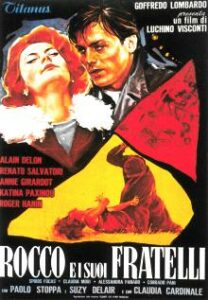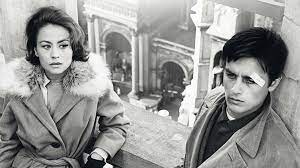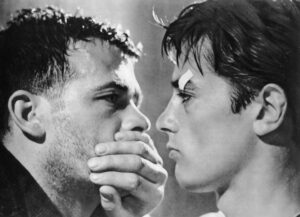„Rocco and His Brothers” – on Behalf of the Family

Title: “Rocco and His Brothers” (“Rocco e i suoi fratelli”)
Release Date: 1960
Director: Luchino Visconti
Cast: Alain Delon, Renato Salvatori, Annie Girardot, Katina Paxinou, Claudia Cardinale
“Rocco and His Brothers” depicts the crisis of a Sicilian family moving to Milan in search of a better life. Luchino Visconti’s masterpiece, however, is not only a testimony to the social changes in Italy in the late 1950s and early 1960s, but a complex tale of human choices between loyalty to the clan and an individual vision of his own life. Rich in references to world literature, the film depicts these problems through the prism of a tragic love triangle, starring Alain Delon, Annie Girardot and Renato Salvatori.
“Rocco and His Brothers” – the social advancement of a Sicilian family
“Rocco and His Brothers” is a monumental work of more than three hours, which is an important link in building Visconti’s position as one of the world’s most important directors. It is the story of the Parondi family from the southern province of Italy (a mother and her five sons), who, after the death of their father, decide to abandon farming and move to Milan. Dreams of a better life collide with harsh reality. Despite the uneasy beginnings, each of the brothers tries to arrange themselves in the metropolitan world, but social advancement and getting rich quickly lead to the loosening of family ties and the lowering of the authority of the mother – the doyenne of the family (played by Katina Paxinou).
The eldest of the family, Vinzenzo, is the fastest to grow into the fabric of Milan, marrying the beautiful but unaccepted by the Parondi mother Ginetta (Claudia Cardinale) and almost cutting himself off from the family. In turn, Simone (Renato Salvatori) and Rocco (Alain Delon) see their chance in professional boxing. The former, intoxicated by a fast career and big money, loses his enthusiasm for training, while the ambitious and disciplined Rocco takes his place.

However, the situation is complicated by Nadia (Annie Girardot), a beautiful and independent prostitute, with whom both brothers fall in love. The woman decides to change her life for Rocco, but he, in the name of a false sense of solidarity, abandons the girl and gives her to Simone, which ends in tragedy: in a frenzy of jealousy, the man murders his lover. Rocco, even then, is unable to see the corruption of his brother, and decides to cover up his crime and pay his debts, pledging to sign a slave contract for the next fights. Simone’s release to the police shocks Ciro, with which he seals his final separation from his family. The only hope for the future is the adolescent Luca, who may have a different, happier fate.
“Rocco and His Brothers” – Visconti’s erudition
“Rocco and His Brothers” is a truly monumental work, in which Visconti demonstrated not only his narrative talent for building a great social and moral parabola, but also the erudition evident in the activation of cultural and literary contexts. The whole movie, which refers in structure to an ancient tragedy, is divided into five parts, each of which is a mini-story about one of the brothers. The title of the film itself is a reference to Thomas Mann’s great novel “Joseph and His Brothers,” based on the biblical story of the son of Jacob and Rachel sold to the Egyptians. The parallel between Joseph and Rocco is based on the peculiar difference of these characters from the rest of the people, their uncommon sensitivity and ability to forgive the worst wrongs. Expressive Old Testament tropes, in turn, give the work a moralistic sense.
“Rocco and His Brothers” also contains allusions to other cultural texts, especially to the prose of Fyodor Dostoevsky. Namely, the tragic story of the love triangle is reminiscent of the story of Rogozhin, Prince Myshkin and Nastaysiya Filipovna. Nadia’s murder, like the one depicted in “The Idiot,” is an expression of the insane desire to completely take possession of the object of love. Only a dead Nadia can belong to Simone completely, just as Nastasya’s corpse can no longer elude Rogozhin. The very evocation of the Russian writer’s prose is an expression of the director’s interest in the dark side of human nature, subconscious instincts, passions and crimes. Dostoevsky and Mann, however, are only the most important contexts of this film, in which one can find traces of Italian literary classics, such as Giovanni Testori.

Social changes in the movie “Rocco and His Brothers”
On a sociological level, “Rocco and His Brothers” portrays the social processes taking place in Italy since the mid-1950s. The mass migration of the population from the poor and agricultural South to the big cities was on a huge scale: more than 2 million people left the province, with certain consequences. Italy transformed into a modern, highly developed country, the traditional class division of the country blurred, and values such as attachment to land or clan lost priority for the newcomers moving up the social ladder. The fate of each brother reflects different scenarios of urban life: from manual labor to a great sports career. The attitudes adopted by the various characters are also varied: pragmatism, romanticism, and even cynical exploitation of other people and the pursuit of deadly goals. The family crisis here is thus a micro-picture of Italy as a whole – drawing attention to the price that is paid for prosperity in a collective sense.
Nevertheless, it is hard not to see that the problem is extremely complex. For the protagonists (with the exception of Rocco) do not miss the lost land at all, and the profits associated with increased comfort rather outweigh, in their minds, any losses. Moreover, the loosening of ties with the matriarchal family gives them a real chance to develop their own individualism and personal dreams. The real source of the tragedy, on the other hand, is not loyalty to the clan, but ill-conceived solidarity, in the name of which Rocco abandons the woman he loves and then protects her murderer.
Therefore, a certain reevaluation is taking place before our eyes: in the finale, the almost symbolic figure of Rosaria the mother reveals another: a dark and cruel face. She turns out to be not only a loving parent with her sons’ best interests at heart, but also the guardian of the old Sicilian order based on gender inequality and justifying honor killing. However, placing the family in the role of an absolute requiring the supreme sacrifice does not absolve a person from moral responsibility for his actions, which is why Rocco’s decisions arouse opposition and incomprehension in the viewer. For we imagine that the story could have taken a completely different course….
Literature:
A. Garbicz, „Kino, wehikuł magiczny. Przewodnik osiągnięć filmu fabularnego. Podróż trzecia”, Kraków
„Kino klasyczne”, pod red. T. Lubelskiego, I. Sowińskiej i R. Syski, Kraków 2012.
